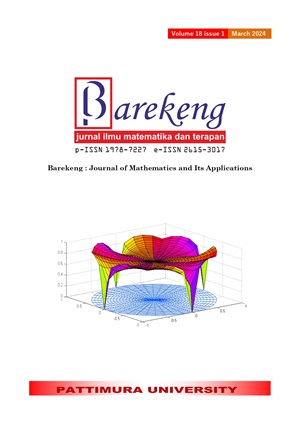A SIR-UC EPIDEMIC MODEL: THE ANALYSIS OF SUSCEPTIBLE-INFECTED-REMOVED (SIR) EPIDEMIC MODEL WITH THE COVERAGE OF HEALTH INSURANCE (UNCOVERED AND COVERED INDIVIDUALS)
Abstract
Susceptible-Infected-Removed (SIR) model is a widely used epidemic model that simulates the spread of infectious diseases within a population. It classifies individuals into susceptible, infected, and removed states, with the number of individuals in each state being time-dependent variables denoted by S(t), I(t), and R(t), respectively. The model considers direct contact transmission between infected and susceptible individuals. In developed countries, some people cannot afford medical treatment. In contrary, the recovery rate of infected individual in the population is directly proportional to the number of people receiving medical treatment. Affordable health insurance increases the number of people receiving medical treatment thus insurance should be considered aspect in epidemic model. The main purpose of this research is to analyze the effect of insurance on the SIR epidemic model. This research classifies individuals in both S(t) and I(t) based on their insurance coverage status. This model assumes permanent immunity for R(t), thus it is unnecessary to classify individuals in this state based on their insurance coverage status because they do not spread the disease nor have potential to be re-infected. Numerical simulation is organized to find the effect of insurance in SIR model by analyzing the equilibrium point. The result based on the equilibrium point suggests that the insurance in SIR epidemic model: (1) decrease the I(t) because it accelerate the recovery rate; (2) decrease theR(t) because there is less infected people for recovery; (3) increase the S(t) because there is less infected people to transmit the disease, compared to the SIR model without the insurance.
Downloads
References
F. Brauer, C. Castillo-Chavez, and Z. Feng, Mathematical Models in Epidemiology. Springer New York, 2019.
E. Vynnycky and R. White, An Introduction to Infectious Disease Modelling. OUP Oxford, 2010.
S. S. Morse, “Emerging viruses: Defining the rules for viral traffic,” Perspect. Biol. Med., vol. 34, no. 3, pp. 387–409, 1991, doi: 10.1353/pbm.1991.0038.
J. A. Al-Tawfiq and Z. A. Memish, “Middle East respiratory syndrome coronavirus: Transmission and phylogenetic evolution,” Trends Microbiol., vol. 22, no. 10, pp. 573–579, 2014, doi: 10.1016/j.tim.2014.08.001.
W. . Kermack and A. . McKendrick, “A contribution to the mathematical theory of epidemics. Proceedings of the Royal Society of London . Series A , Containing Papers of a Mathematical and physical Character, Vol. 115, No. 772.,” Society, vol. 115, no. 772, pp. 700–721, 1927.
H. W. Hethcote, “The Mathematics of Infectious Diseases,” Soc. Ind. Appl. Math., vol. 42, no. 4, pp. 599–653, 2000.
D. L. Smith, J. Dushoff, E. N. Perencevich, A. D. Harris, and S. A. Levin, “Persistent colonization and the spread of antibiotic resistance in nosocomial pathogens: Resistance is a regional problem,” Proc. Natl. Acad. Sci. U. S. A., vol. 101, no. 10, pp. 3709–3714, 2004, doi: 10.1073/pnas.0400456101.
C. T. Bauch and D. J. D. Earn, “Vaccination and the theory of games,” Proc. Natl. Acad. Sci. U. S. A., vol. 101, no. 36, pp. 13391–13394, 2004, doi: 10.1073/pnas.0403823101.
F. M. Thakur R, Sangar S, Ram B, “Quantifying the burden of out-of-pocket health expenditure in India,” Public Health, vol. 159, pp. 4–7, 2018.
W. Lestari, L. Trisnantoro, and N. Andayani, “Gambaran Kinerja Rumah Sakit Sebelum Dan Sesudah Era Jaminan Kesehatan Nasional (Jkn),” J. Manaj. Pelayanan Kesehat. (The Indones. J. Heal. Serv. Manag., vol. 24, no. 03, pp. 95–101, 2022, doi: 10.22146/jmpk.v24i03.4130.
R. M. Anderson and R. M. May, Infectious Diseases of Humans: Dynamics and Control. OUP Oxford, 1991.
M. El Hajji, S. Sayari, and A. Zaghdani, “Mathematical analysis of an ‘SIR’ epidemic model in a continuous reactor-deterministic and probabilistic approaches,” J. Korean Math. Soc., vol. 58, no. 1, pp. 45–67, 2021, doi: 10.4134/JKMS.j190788.
O. Diekmann, J. A. P. Heesterbeek, and J. A. J. Metz, “On the definition and the computation of the basic reproduction ratio R0 in models for infectious diseases in heterogeneous populations,” J. Math. Biol., vol. 28, no. 4, pp. 365–382, 1990, doi: 10.1007/BF00178324.
T. Britton, F. Ball, and P. Trapman, “A mathematical model reveals the influence of population heterogeneity on herd immunity to SARS-CoV-2,” Science (80-. )., vol. 369, no. 6505, pp. 846–849, 2020, doi: 10.1126/science.abc6810.
W. C. Lu, J. F. R., Hsiao, “The Impact of Health Insurance Coverage on the Utilization of Medical Services: Evidence from a Natural Experiment in Taiwan,” J. Am. Med. Assoc., vol. 290, pp. 2877–2885, 2003.
K. Finkelstein, A., Taubman, S., Wright, B., Bernstein, M., Gruber, J., Newhouse, J. P., & Baicker, “Health Insurance Coverage and Health - What the Recent Evidence Tells Us,” N. Engl. J. Med., vol. 367, pp. 299–301, 2012.
Copyright (c) 2024 Sutanto Sutanto, Dewi Retno Sari Saputro, Alexander Yonathan Christy, Aslina Baharum

This work is licensed under a Creative Commons Attribution-ShareAlike 4.0 International License.
Authors who publish with this Journal agree to the following terms:
- Author retain copyright and grant the journal right of first publication with the work simultaneously licensed under a creative commons attribution license that allow others to share the work within an acknowledgement of the work’s authorship and initial publication of this journal.
- Authors are able to enter into separate, additional contractual arrangement for the non-exclusive distribution of the journal’s published version of the work (e.g. acknowledgement of its initial publication in this journal).
- Authors are permitted and encouraged to post their work online (e.g. in institutional repositories or on their websites) prior to and during the submission process, as it can lead to productive exchanges, as well as earlier and greater citation of published works.






1.gif)



